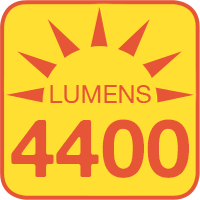
Simply place the light in front of your door, and this will enhance the security of your home or office.Ĭamping: When you’re camping, you will want to make sure that you have a light source with which to see in the dark. That’s where 800 lumens comes in handy because it provides sufficient brightness that allows riders to ride safely at night or during low-light conditions.Įntrance Light: In order to safely enter your home or office at night, it is important that you have bright light.
#2 400 LUMEN LIGHTS EQUAL 800LUMENS DRIVERS#
If your bike light is not bright enough, it can be quite dangerous for both you and other drivers around you. And with biking, you will need to be able to see the path in front of you while riding. Though it’s been proven that an 800 lumens bulb will cover 200 meters of distance, I would recommend using it within 150 meters.īike Light: More and more people are adopting biking as a sport. And that’s what 800 lumens can do in a room. Can you imagine 800 candle lights lit up at once? It would be incredibly bright for a small space. Such as:īedroom: Generally, 1 lumen is equivalent to the brightness of 1 candle. Well, there are many places where this kind of light can be put to good use. Now, I am going to discuss a very important question which is some people might be wondering about where they can use the 800 lumens light.

Where Can I use 800 lumens light? Some real-life examples The more the distance, the less amount of brightness you’re going to be able to receive. But keep in mind that the actual brightness will be higher at a closer range. Well, according to the table above, and considering its wattage, 800 lumens can reach a distance of about 200 meters. This is because some of us are not sure if 800 lumens is bright enough to be used in a large area. I know those who have read this blog post might be wondering how far the 800 lumens can reach.

Type Of BulbĪverage energy efficiency between 12 lumens per watt (lm/W) and 18 lumens per watt.Īverage energy efficiency between 16 lumens per watt (lm/W) and 29 lumens per watt.Īverage energy efficiency is between 40 lumens per watt (lm/W) and 60 lumens per watt.Īverage energy efficiency is between 80 lumens per watt (lm/W) and 100 lumens per watt. To make you understand more about the brightness, here is a table of 800 lumens to watts. Overall, the perfect word that can describe 800 lumens brightness for general usage, I can say it’s “decent.” However, When I tried to see what 800 lumens looked like and how bright it was, I found that it provided a good brightness in my bathroom. It’s powerful and efficient so that it can handle various tasks with ease. What’s actually true is that 800 lumens are bright enough for most needs. Some people felt that it was plenty bright for most needs, while others said that they would need to supplement the light with another source. When I was talking with some friends about how bright is 800 lumens, they all had different perspectives on the answer. However, in this guide about how bright is 800 lumens, we’ll tell you what to expect when using this level of brightness. It’s bright enough to see when you’re working in a well-lit office, and it’s suitable to handle most tasks.

So 800 lumens is definitely bright enough for most needs. Same level of brightness, different amount of power required to produce it.800 lumen is equivalent to 60 watts of incandescent light.

However, for a less-efficient halogen bulb, over 60 watts of powerĪre likely to be required to produce the same brightness. For an LED bulb, producing 1,300 lumens will require around 15 watts of power. Let's imagine that you are looking for an extremely bright bulb that emits 1,300 lumens. Figures for lumens appear on the packaging of all light bulbs and allow us to compare the brightness (or dimness) of a bulb. As low-wattage bulbs become more commonplace, we need a better way of measuring their output. Modern energy-efficient bulbs use much less power (wattage) when compared to their incandescent and fluorescent counterparts. Total quantity of visible light emitted by a light source. By contrast, the lumen is a unit of brightness, a measure of the Most of us are familiar with the power ratings associated with lightbulbs measured in watts (25 watts, 40 watts and 100 watts are common examples).


 0 kommentar(er)
0 kommentar(er)
